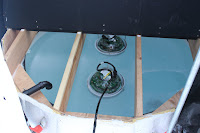Since I got back to Washington, D.C., earlier this week, I have already lost 24 pounds ... of clothing. While South Pole residents do tend to lose 10-15 pounds in body mass because they are constantly fighting cold temperatures, there are much more dangerous dangers than this -- hypothermia and frostbite, for example. I've mentioned "ECW" (Extreme Cold Weather) gear throughout my travels in Antarctica, so I wanted to show you exactly what this consists of and how U.S. Antarctic Program participants prevent cold weather-related injuries.
It all starts at the Clothing Distribution Centre in Christchurch, where each participant receives two duffel bags full of clothing. Fashion is not important, as everyone will look the same once they don their "Big Red" parkas and their 10 pound "bunny boots":


Here's all the gear I was given:

The first few layers are base layers that wick moisture (sweat) away from your skin: polypropylene long underwear, wool socks and a light-weight fleece jacket and pants.

The next layers are windproof overalls or "bibs" and the infamous "bunny boots," which have extra room for air and felt liners (great insulators):

Then a windproof fleece jacket:

The big, red parka fluffed with goose down ...

A balaclava (fleece head-and-face warmer) or neck gaiter/hat combination:

And finally, ski goggles, glove liners and thick leather gloves or fleece/down mittens.

When visiting the South Pole and field sites or while traveling in airplanes and helicopters, participants are required to wear the essential ECW gear (long underwear, wool socks, fleece pants and jacket, bunny boots, a hat, gloves/mittens and "Big Red") and hand-carry the other items, in addition to extra socks, gloves and a toothbrush -- just in case you're stuck overnight. At these cold locations, it is not a good idea to have skin exposed, as frostbite can happen very quickly.
Some locations, such as McMurdo and the Dry Valleys, experience above-freezing temperatures. In this case, one can shed a few layers. But, it is still important to wear polarized, 100% UV protective sunglasses to prevent snow blindness (85% of sunlight that hits the ice is reflected) and high spf sunscreen on any exposed skin (the atmosphere -- and thus the ozone layer that blocks UV light -- is thinner at the Poles).
Ok, I must admit, even though it is above freezing in Washington right now, it feels colder with all the moisture in the air. I wish I had "Big Red" to throw on for my evening commute! What a fashion statement that would make on the Metro ...
 It's been a while, eh? Antarctic winter will officially be over next Wednesday, September 22, while we in the Northern Hemisphere will experience autumnal equinox -- the first day of fall. The sun will rise at the South Pole for the first time since mid-March. And let me tell you, the staff will be happy to see it!
It's been a while, eh? Antarctic winter will officially be over next Wednesday, September 22, while we in the Northern Hemisphere will experience autumnal equinox -- the first day of fall. The sun will rise at the South Pole for the first time since mid-March. And let me tell you, the staff will be happy to see it!














































